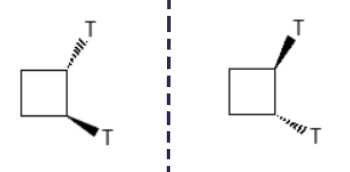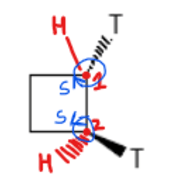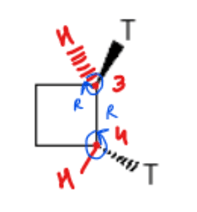How would we determine the optical activity in a compound as such:
The biggest difficulty I'm having is determining the R-S configuration as that will determine whether the pair are enantiomers or diastereomers (they cannot be mesomers).
My attempt:
We know that the Carboncarbon having the Tritiumtritium atom will always have a higher priority than the Carboncarbon having a regular Hydrogenhydrogen (as per CIP Rulerule).
Since $C_1$ has the lowest priority group (Hydrogenhydrogen) at the Lineline and not the Dashdash, and the rotation is clockwise, it has S configuration.
Similarly for $C_2$, since it has Hydrogenhydrogen at the Dashdash, and the rotation is anti-clockwise, it has S configuration.
For it's mirror image,
$C_3$ has Hydrogenhydrogen at the Dashdash and the rotation is clockwise, so it has R configuration.
As for $C_4$, it has Hydrogenhydrogen at the Lineline and not the Dashdash, and rotation is anti-clockwise, so it has R configuration.
Since configuration of both Carboncarbon atoms changes in the mirror image, they should be Enantiomersenantiomers, however they are supposedly Diastereomersdiastereomers.
Why are the pair of compounds diastereomers and could someone point out where I'm going wrong?



